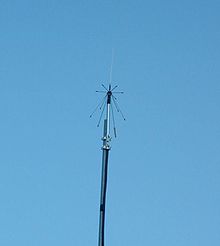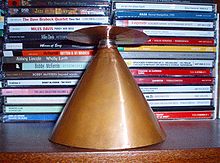- Discone antenna
-
A discone antenna is a version of a biconical antenna in which one of the cones is replaced by a disc. It is usually mounted vertically, with the disc at the top and the cone beneath.
Omnidirectional, vertically polarized and exhibiting unity gain, it is exceptionally wideband, offering a frequency range ratio of up to ~10:1. The radiation pattern in the horizontal plane is quite narrow, making its sensitivity highest in the plane tangent to the Earth's surface.
Contents
History
On February 6, 1945, Armig G. Kandoian of New York was awarded U.S. patent number 2,368,663 (assignor to Federal Telephone and Radio Corporation (later merged with ITT Corporation) for a "broad band antenna", from an application made on May 15, 1943.
Excerpt from the Kandoian patent:
In keeping with progress made during the last few years in the development of ultra-high frequency radio technique, and applications thereof to aircraft communication, direction finding, and so forth, it has become necessary to develop special antennas and antenna systems suitable for installation on such aircraft. Flying conditions are such that these antennas must necessarily be small and rigid in their construction and also offer a minimum of wind resistance, in order that the flying efficiency of the aircraft will be unimpaired. In accordance with my invention I have provided a small rigid antenna suitable for mounting on the surface of the fuselage or other component of the airplane structure and in certain embodiments I have also provided a streamlined protecting shield or housing covering or so cooperating with the construction of the antenna system as to greatly reduce wind resistance.
Applications
The discone's wideband coverage makes it attractive in commercial, military, amateur radio and radio scanner applications.
When employed as a transmitting antenna, it is often less efficient than an antenna designed for a more limited frequency range. SWR (standing wave ratio) is typically ~2:1 over the range of the design frequency to the second harmonic and ~3.1 thereafter.
The discone's inherently wideband nature permits it to broadcast undesirable spurious emissions from faulty or improperly filtered transmitters.
Construction materials
A discone may be made from solid metal sheet (often copper), which is practical for small indoor UHF antennas, such as for Wi-Fi.
At lower frequencies a sufficient number of metal wires or rods in a spoke configuration is often used to approximate a solid surface. This simplifies construction and reduces wind loading.
The spokes may be made of stiff wire, brazing rods or even coat hanger wire.
The optimal number of rods comprising the disc and cone is often quoted as being from 8 to 16.
Components
A discone antenna typically has at least three major components: the disc, the cone, and the insulator.
The disc
The disc should have an overall diameter of 0.7 times a quarter wavelength of the antenna's minimum frequency.
The antenna's feed point is at the center of the disc. It is usually fed with 50-ohm coaxial cable, with the center conductor connected to the disc, and the outer conductor to the cone.
The cone
The length of the cone should be a quarter wavelength of the antenna's minimum operating frequency.
The cone angle is generally from 25 to 40 degrees.
The insulator
The disc and cone must be separated by an insulator, the dimensions of which determine some of the antenna's properties.
Extending low-frequency response
A vertical whip may be placed affixed vertically to the disc in order to extend the low frequency response, but this may reduce efficiency at higher frequencies. In this configuration, at lower frequencies the discone may more closely resemble a ground plane antenna or a coaxial dipole.
See also
References
External links
- Kandoian's patent
- Discone design program
- Tim's Discone Antenna
- UHF Discone Antenna
- The Discone Antenna
- Parabolic Discone (Michael Lake KD8CIK)
- Highest Gain Discone Antenna Ever (Michael Lake (KD8CIK) - eham.net discussion of above
- VHF/UHF Discones
- text and construction hints
- Broadband radial discone antenna: Design, application and measurements
- Antenna Magus Antenna Magus, an antenna design tool, contains a Discone antenna.
Antenna types Isotropic Omnidirectional Coaxial antenna · Dipole antenna · Discone antenna · Folded unipole antenna · Ground-plane antenna · Helical antenna · J-pole antenna · Mast radiator · Monopole antenna · Random wire antenna · Rubber Ducky antenna · T2FD Antenna · Whip antennaDirectional AWX antenna · Beverage antenna · Cantenna · Collinear antenna · Fractal antenna · Ground dipole · Helical antenna · Horizontal curtain · Horn · Inverted vee antenna · Log-periodic antenna · Loop antenna · Microstrip antenna · Patch antenna · Phased array · Parabolic antenna · Plasma antenna · Quad antenna · Reflective array antenna · Regenerative loop antenna · Rhombic antenna · Sector antenna · Short backfire antenna · Slot antenna · Turnstile antenna · Vivaldi-antenna · Yagi-Uda antennaApplication-specific Categories:- Radio frequency antenna types
Wikimedia Foundation. 2010.


